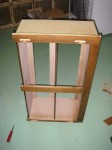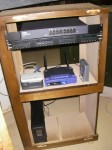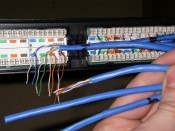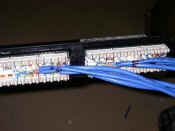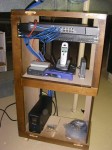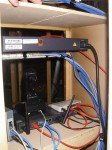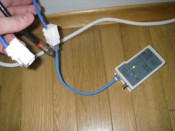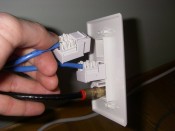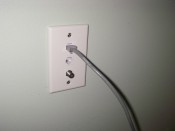Terminating Network Cables
After running network cables the next step, of course, is to terminate them.
Using one of the old cabinets that happened to be close to the right size, I built a rudimentary 19″ rack. It’s not too bad for a DIY rack, especially considering a small swing-out metal rack costs around $250.
I basically took an old cabinet, cut the middle shelf out and turned the whole thing on its side. I added another piece of wood from another cabinet on the other end as a mounting location for the rack-mount gear, and I pre-drilled several pilot holes at 1U spacing (to prevent the wood from cracking when putting in screws). I used part of the old middle shelf to build a new shelf to hold my modem, router, VoIP adapter, etc.
I terminated all the cables from the jacks throughout the house onto the back of a 1U 24-port patch panel.
On the main floor I have 12 jacks so far – 2 network + 1 cable in each of 3 bedrooms; 2 network + 1 cable in two separate locations in the living room; 2 network on a wall shared by kitchen/dining room. I probably would have put another jack (and a cable hookup) in the kitchen, except that I plan on doing some major renovations there in the next couple of years, so I’ll just wait, since I don’t need them now anyways.
There are a couple of benefits to using a patch panel for this job. Any “network” jack in the house can be made into either an Ethernet jack, or an analog phone line. Since I use a VoIP PBX at home, I can actually put analog extensions anywhere I’d like, and keep the VoIP adapter in the rack (like the Linksys PAP2 you see on the right). Additionally, I can use PoE injectors (or a PoE switch) and selectively send PoE to ports that need it (eg, have a VoIP phone plugged in).
I can also run different networks to different spots in the house. Most people probably wouldn’t use this, but my main MythTV server (currently in my living room) is also my PBX server, and it has a public IP (VoIP traffic on its own IP avoids QoS issues). I have a hub on my cable modem that splits the connection to the router, and sends another “raw internet” line up to the PBX server (red cable going into the patch panel).
The other end of every connection is pretty simple. I ordered all the keystone jacks, wall plates and patch cables from monoprice.com. The jacks are 1⁄5 the price Home Depot sells them for, and the patch cables are sold for cheaper than I can buy the parts to make them myself.
